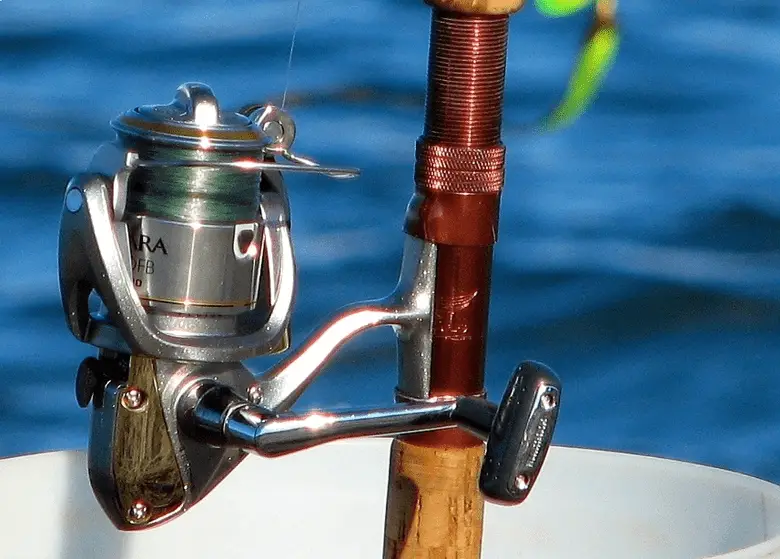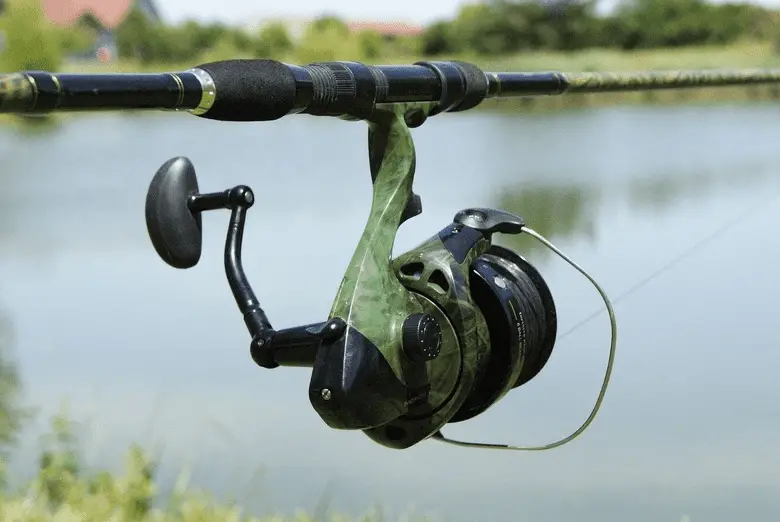Today I’d like to discuss a crucial aspect of fishing – how much line to put on your fishing reel?
Many experienced anglers might see this question as a little odd.
However, the number of times I see spinning reel tangles due to overfilling, line damage when spooling at an incorrect pressure, and poor casting from underfilling the spool, suggest that it’s a good time to address the problem.
Here is what you will learn:
Why is the Amount of Line You Put on a Reel Important?
How Much Line Should You Spool on a Spinning Reel?
Spooling at an Incorrect Pressure
How Many Yards of Braided Line Do I Need for a Spinning Reel?
Page Contents
Why is the Amount of Line You Put on a Reel Important?
In short, the amount of line you put on your spin reel impacts its performance. If you fill your reel with a line class specified by the manufacturer, you should not have any problems.
A spinning reel should be filled immediately below the point where the inside of the spool lip begins to bevel. If in doubt, slightly less is a better option than too much.
Spool lips vary in construction, so sometimes it’s unclear where to finish a fill. The bottom line is that the spool lip needs to sit above the fishing line so it can retain it.
What you are aiming for is the sweet spot where the line is retained without looping off all at once, yet the reduction of friction is optimized.
Friction is what we are trying to avoid because friction kills casting distance, accuracy, and eventually, the line itself.
How Much Line Should You Spool on a Spinning Reel?

We’ll look at reel specifications shortly, but before that, we need to look at a few problems that arise from poor spooling.
Adding Too Much Line
When you overfill your spinning reel spool it’s nearly a certainty that you’ll end up with wind knots and loop knots and an inability to stop line springing from your spool while it’s at rest.
When you cast an overfull spool, the line will tend to peel off in multiple layers at once.
You may even find that every layer above the spool lip comes off all at once, getting caught on the reel itself, or jamming in one of the rod guides.
Whatever the case, it’s a knot you’ll be cutting free, if the line hasn’t snapped already owing to the force at which it was created.
Often the sudden stop as the clump of tangled line stops or jams in a guide is enough to send your rig or expensive lure free-flying out into the water, never to be seen again.
I have seen worse too. When braid is being used I have seen it blow off overfull spools because of wind unbeknownst to the angler as they cast.
It catches a finger, and the cuts it causes can be extremely bad. Particularly if you’ve loaded up for a huge cast with a heavy rig.
There is no value at all in overfilling your spool. All it causes is trouble, knots, lost rigs, broken guides, snapped rod tips, fishing downtime, and even injury.
Spooling at an Incorrect Pressure
Many anglers believe spooling a spinning reel with too much tension causes line damage, such as cuts – particularly in braid.
The opposite is true.
If you spool without enough pressure on the feeder spool, firstly, you will underfill your spool, and secondly, and most critically, you can cause significant line damage.
A spool filled with appropriate or tighter-than-average tension delivers an even and solid line lay between line layers.
With inadequate and inconsistent pressure spooling pressure, each layer grips the last with variable tension.
The result is that when you cast, and then retrieve under load, the line layers sitting loosely underneath, will press down, often cutting into the line causing damage, and/or squeezing and distorting the loose layers.
The results of inconsistent line lay from poor inadequate spooling pressure can result in damaged line, poor casting performance, and a significantly increased propensity for knots.
Underfilling the Spool
Underfilling your spool will have an immediate impact on casting distance and accuracy.
With an underfilled spool, the distance between the line layers and the spool lip creates far greater friction, which is also inconsistent.
The other obvious problem can really hurt.
And that’s when you hook a trophy fish, yet don’t have enough line to arrest a charging run, at maximum practical drag pressure.
Losing a trophy catch because of an underfilled spool hurts more because it could have been avoided.
How Many Yards of Braided Line Do I Need for a Spinning Reel?

Every spinning reel will have line-class specifications printed on the spool. These days they will include specifications for both mono and braid.
It’s often easier to check the instructions or search the manufacturer online for greater detail and accuracy.
Not all 20-pound braid will be the same line diameter.
Close, yes, but not always the same. And it’s line diameter, not test weight, that determines how much line will fit onto a spool.
Many anglers will select braids, and mono especially, based on the ratio of high strength to low diameter. The lower the diameter of the line, the more you will fit on a spool.
While line diameter is the most accurate measurement for understanding how much braid to fit on a spool, test weight specifications provide as much accuracy as you will need.
Many braid users will spool up a portion of their spinning reels with mono, and then connect braid to the top of the spool.
As a result, spooling is made easier, but more importantly, it saves anglers the cost of filling an entire spool with an expensive braid.
For the most part, few anglers will ever see the bottom half of their spool under regular conditions.
In essence, braid ‘stored’ like this on the spool, can be considered a bit of a waste.
The ratio of braid to mono backing varies considerably between anglers and can be as much as 80% braid, down to 40% or less for the truly frugal.
It usually depends on how often you expect extra-long casts, and extra-long runs during a fish fight.
Frequently Asked Questions
Is 125 Yards of Fishing Line Enough?
On a top-shelf 1000 size spinning reel such as the Daiwa Exist, 125 yards of 8-pound mono would be enough.
Above this reel size, using 125 yards only will start affecting casting performance unless you increase line diameter significantly.
Let’s rephrase the question.
Can I still catch a decent size fish, better than panfish size, on a 3000 size spin reel spooled with only 125 yards of line?
The answer is emphatically yes. Everyday. Can I take a 50 pound GT with 125 yards of 20-pound braid on any size reel? It’s unlikely.
You compromise spin reel performance for every iteration outside the standard spec you take.
For each degree of compromise, you’re closer to a point where you will inhibit your chances of catching fish.
How Much Line do I Need for a 2500 Reel?
A 2500 spin reel is a close-quarters, finesse-style fishing reel. While line capacities of these reels have grown over the last couple of decades, they don’t hold a huge amount of line.
A high-end 2500 Daiwa Exist holds 150 meters of 12-pound mono, the compact model holds 100 meters of 8 pound.
A mid-priced comparison is the PENN Battle III which holds 140yds of 10lb mono and 240 yards of 10-pound braid.
An entry-level 2500 such as the popular Shimano Sienna will hold 140 yards of 8lb mono and 170 yards of 10lb braid.
While I have grouped these reels in price categories, this was just to illustrate that price is no indicator of spool capacity.
Just like you will find many variations in diameter of the same test weight line, you will also find plenty of variations between spool capacities of reels with the same size designation.
It’s important to note that there are few if any standard weights and measures dictating reel sizes and capacities in fishing reels and lines.
In many respects, the sizes and capacities in fishing appear a little arbitrary. While this might feel a little confusing, it’s not really.
You will find much of the variation in the same size line and reel, model to model, and brand to brand, is negligible and generally irrelevant for the average angler.
How Much Line Should a 4000 Reel Have?
A 4000 size spinning reel is in the all-rounder class and can handle pretty hefty fish for its size. It’s a good size for big inshore predators and an excellent surf reel size.
With the fighting capacity of a high-end, mid-priced 4000 pretty significant these days, a capacity of 300 meters of PE2 (20-kilo braid) allows you to tackle fish well above the test weight or line class.
Again, stick to the specifications as designated by the manufacturers for best performance.
What is Braid Capacity on a Reel?
Braid capacity is the amount of Braided fishing line your reel will hold for optimum performance.
Braid has a much thinner diameter than mono, therefore your reel will hold more braid than mono.
How is spool capacity calculated?
To calculate line capacity you will need to know the dimensions of the line-holding section of your spool: the arbor diameter, spool depth, and spool height to the start of the bevel.
You will also need to know the diameter of your fishing line.
Such a process would be taking line calculations to next level, fine for math boffins, but a little tedious for the average angler and, by and large, unnecessary.
Big blue water game anglers, particularly comp and pro anglers, are the people most likely to find such an equation useful and relevant.
However, with conversion and size charts such as this chart available online, why hurt your brain?
This chart, plus your reel specs, is all you need to estimate the amount of line, braid, mono that your reel will hold.
Sharing is caring!
